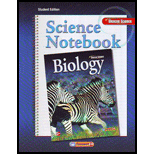
Concept explainers
To define:
The terms medusa, polyp, nerve net, gastrovascular cavity, nematocyst, cnidocyte, sessile, and filter feeder.
Introduction:
A cell is the structural, functional, and biological unit of all living organisms. It is smallest unit for life. A cell can be prokaryotic or eukaryotic. Eukaryotic cells contain membrane bound cell organelles, that help in functioning of cellular machinery by carrying out biochemical reactions.
Explanation of Solution
Medusa − It is a type of body form found in phylum Cnidaria that are invertebrates. The medusa body is umbrella shaped or bell shaped. Their mouth opens into the main body cavity.
Polyp − It is small clump of cells that grows inside animal’s body. They are of two types, pedunculated polyps and sessile polyps. Pedunculated polyps hang from a stalk, while sessile polyps are flat.
Nerve net − It is the diffused network of cells that together forms ganglia in some living beings. It can be easily found in nerve net.
Gatsrovascular cavity − It is a structure that is found in primitive animals. It functions to digest food and transport nutrients throughout the body.
Nematocyst − It is a special cell found in the tentacles of jellyfish and some coelenterate. It is used for killing prey and in self-defence.
Cnidocyte − It is an explosive cell that contains cnidocyst, a secretory organelle. Cnidocyst transfers sting to other living beings. Cnidocytes are found near the mouth and the tentacles and helps in preying and repelling predators.
Sessile − Sessile organisms are found attached permanently to something. An external force is required to move them from their location.
Filter feeder − These are suspension feeding animals that feed food which is strained from water. Filter feeding is seen in invertebrates and some vertebrates like baleen whales.
Additional Science Textbook Solutions
Biological Science
Microbiology: An Introduction (13th Edition)
Microbiology with Diseases by Taxonomy (5th Edition)
Human Biology: Concepts and Current Issues
Human Biology: Concepts and Current Issues (8th Edition)
 Human Anatomy & Physiology (11th Edition)BiologyISBN:9780134580999Author:Elaine N. Marieb, Katja N. HoehnPublisher:PEARSON
Human Anatomy & Physiology (11th Edition)BiologyISBN:9780134580999Author:Elaine N. Marieb, Katja N. HoehnPublisher:PEARSON Biology 2eBiologyISBN:9781947172517Author:Matthew Douglas, Jung Choi, Mary Ann ClarkPublisher:OpenStax
Biology 2eBiologyISBN:9781947172517Author:Matthew Douglas, Jung Choi, Mary Ann ClarkPublisher:OpenStax Anatomy & PhysiologyBiologyISBN:9781259398629Author:McKinley, Michael P., O'loughlin, Valerie Dean, Bidle, Theresa StouterPublisher:Mcgraw Hill Education,
Anatomy & PhysiologyBiologyISBN:9781259398629Author:McKinley, Michael P., O'loughlin, Valerie Dean, Bidle, Theresa StouterPublisher:Mcgraw Hill Education, Molecular Biology of the Cell (Sixth Edition)BiologyISBN:9780815344322Author:Bruce Alberts, Alexander D. Johnson, Julian Lewis, David Morgan, Martin Raff, Keith Roberts, Peter WalterPublisher:W. W. Norton & Company
Molecular Biology of the Cell (Sixth Edition)BiologyISBN:9780815344322Author:Bruce Alberts, Alexander D. Johnson, Julian Lewis, David Morgan, Martin Raff, Keith Roberts, Peter WalterPublisher:W. W. Norton & Company Laboratory Manual For Human Anatomy & PhysiologyBiologyISBN:9781260159363Author:Martin, Terry R., Prentice-craver, CynthiaPublisher:McGraw-Hill Publishing Co.
Laboratory Manual For Human Anatomy & PhysiologyBiologyISBN:9781260159363Author:Martin, Terry R., Prentice-craver, CynthiaPublisher:McGraw-Hill Publishing Co. Inquiry Into Life (16th Edition)BiologyISBN:9781260231700Author:Sylvia S. Mader, Michael WindelspechtPublisher:McGraw Hill Education
Inquiry Into Life (16th Edition)BiologyISBN:9781260231700Author:Sylvia S. Mader, Michael WindelspechtPublisher:McGraw Hill Education





